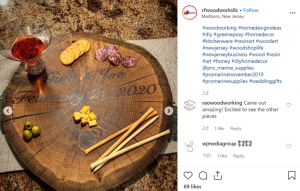How can a small business owner get a jump on the new year? The best way to prepare is to outline your marketing goals and plan your social media content calendar accordingly.
We’re jumping into this topic so that social media will become a helpful tool instead of a daunting chore. Here are some important first steps:
- Set your goals for each month
- Leverage your audience
- Learn what content works best
How Can You Set the Right Goals for Social Media?
When business owners shift their mindset and think of social media platforms as a tool, goals become clearer. Ask yourself, ‘how can social media platforms work for my business?’
The immediate response is almost always, ‘increase sales.’
Here’s the honest truth from HopperHQ, ‘Your business goals may certainly include sales and increased profits. But getting to those goals via social media involves a very indirect approach. Any social media content plan you develop must honor this indirect approach.’ What they mean is build relationships first, sell second.
Let’s check out some examples of correct ways to set indirect goals that could provide higher sales:
- ‘I need more people to visit us and recognize who we are as a business.’
This goal is all about brand awareness. It’s getting the right people in front of your brand in a way that creates engagement. It’s not enough to showcase your products.
Take a tip from influencers. Those folks have huge audiences because they engage with people the same way as if they saw them on the street. Put in the effort and create meaningful conversations on social media. The comments and shares will soon follow the more consistently you practice this.
- ‘I need a simplified way to respond to inquiries.’
This goal focuses on maintaining current customers. Any good business knows it’s easier to keep a customer than to get a new one.
The key to communication up-keep on social media is to manage expectations and respond immediately. Be clear on when exactly you or your team will be online to answer questions and where questions can be submitted. If you want to handle inquiries on Twitter, whether it’s for one hour or five hours, state that in your bio for people to see.
How Can You Maximize the Relationship between Your Audience and Social Media?
How do you leverage your fans to help you with your social media game? First, check into the demographics.
Understanding your target audience, their specific pain points, and which platforms they’re using will help you deliver value to the right people.
According to Social Sprout, here are a few key demographics for some of the leading social platforms.
On Facebook, the go-to audience is female between the ages of 18 and 49. Users on Instagram are pretty similar to Facebook. The most significant difference is the lower age range between ages 13 through 29.
Twitter and LinkedIn are similar in that gender is just about split down the middle. Twitter’s main age range is 18 through 29, whereas LinkedIn comes in between 18 to 49.
User demographics for social platforms are easily searchable and are frequently updated. When you find a platform that matches your target market, the next thing on your checklist is creating a strong presence.
The content you publish on social media should revolve around two things: one, emphasizing meaningful conversation and two, solving your audience’s problems.
We’ve mentioned meaningful conversations a few times in this article because it really can make a difference in social media. But what’s the easiest way to begin? It’s not about asking the right questions but asking the easy ones. For example,
“Does this Monday morning have you 🤗 or ☕?”
To solve your fans’ problems, you need to understand what those problems are. There’s only one tried and true way to do this. And that’s by asking directly.
If you have a brick in mortar store, it’s as easy as going up to a customer and asking how you can help. Other ways are picking up the phone or sending out surveys to email lists.
Your social media game will rise when you’re able to tailor your content around your audience.
What Kind of Content Hits Big in the World of Social Media?
Social media is the string that connects you with millions of people who could become your number one fan. There are so many different types of content that could resonate your followers. For example,
- Articles/Blogs. Solves a problem for your audience.
- Engaging content that builds trust.
- Giveaways/Contests. Helps you expand your reach and gain new followers. Be careful to set the right guidelines so you don’t just attract people just for free stuff.
- User-Generated Content. UGC builds trust and helps you interact with your fans. It’s also an easy way for you to produce content more frequently.
- Quotes/Memes. Entertainment. Easy items to share with your audience in ways that really relate to them.
Here are some examples of local businesses killing it with different types of content.
With a simple post that shares insight on the owners of the salon, it hit 182 reactions and 21 comments.
Giveaways, contests, or quizzes can be a great way to reward your fans for interacting with you. Euphemia Bloom Books used a simple illustration to promote their giveaway back in October. The owners behind this small business are very clear on the guidelines, which we applaud!
There is a smart way to showcase your products. CF Woodworks did an awesome shout out to one of their customers, which brought this post 69 reactions and a handful of comments.
Using quotes or memes in your social media content can get tricky. The best way to handle it is by presenting something that’s relatable, not just any old quote you pull from Google. Learn about your audience and use emotions that will appeal to their daily life. Then, like Kelsey McQuillin, you’ll see great interaction. Keep in mind it’s a testing process.
So, if you want to start 2020 with a bang using social media:
- Think about your marketing goals and the platforms that can help you reach them.
- Learn the ins and outs of your target audience so you can determine which platforms you should be on and what types of content to publish.
- Remember to vary your posts to see what works best.




